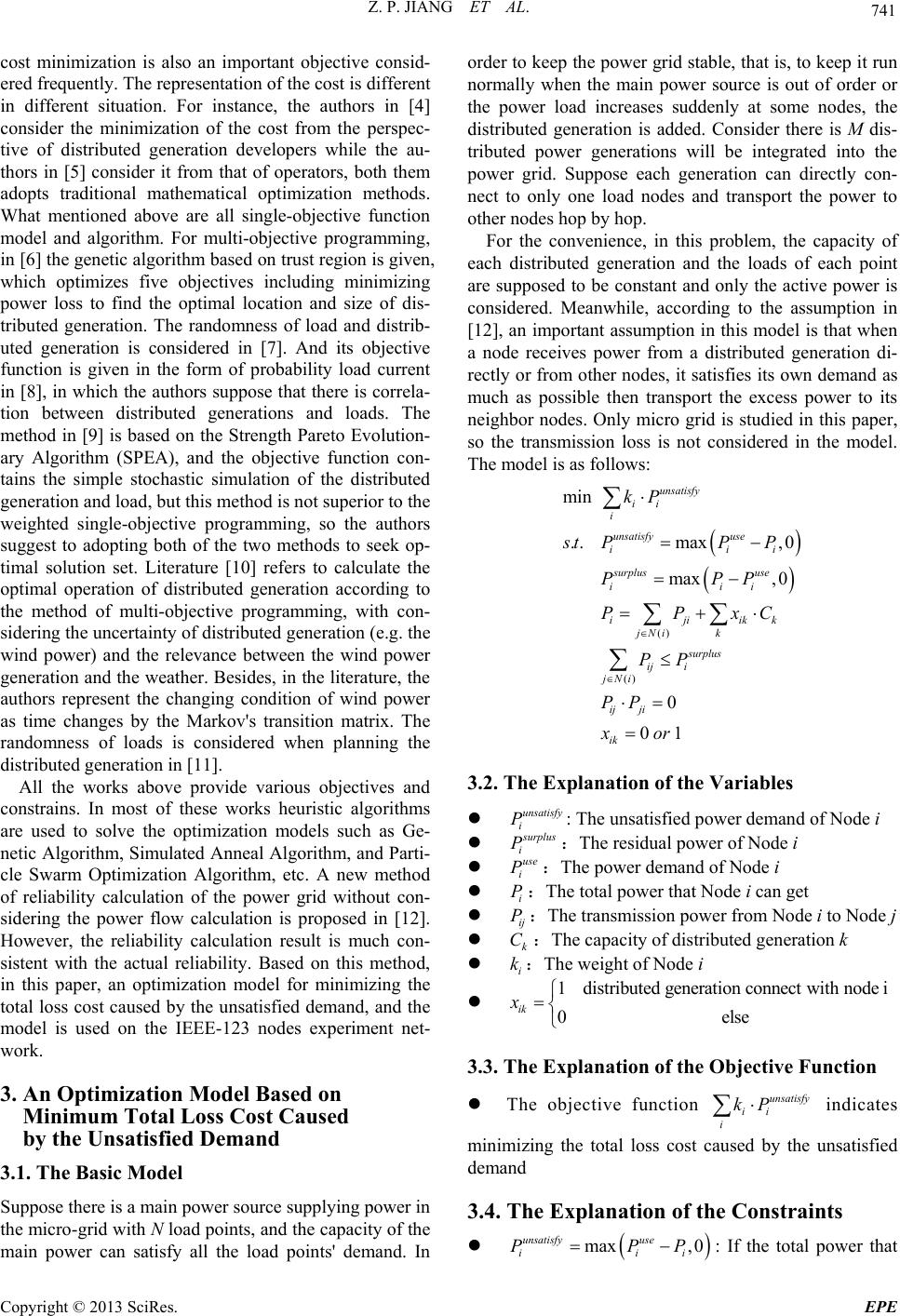
Z. P. JIANG ET AL. 741
cost minimization is also an important objective consid-
ered frequently. The representation of the cost is different
in different situation. For instance, the authors in [4]
consider the minimization of the cost from the perspec-
tive of distributed generation developers while the au-
thors in [5] consider it from that of operators, both them
adopts traditional mathematical optimization methods.
What mentioned above are all single-objective function
model and algorithm. For multi-objective programming,
in [6] the genetic algorithm based on trust region is given,
which optimizes five objectives including minimizing
power loss to find the optimal location and size of dis-
tributed generation. The randomness of load and distrib-
uted generation is considered in [7]. And its objective
function is given in the form of probability load current
in [8], in which the authors suppose that there is correla-
tion between distributed generations and loads. The
method in [9] is based on the Strength Pareto Evolution-
ary Algorithm (SPEA), and the objective function con-
tains the simple stochastic simulation of the distributed
generation and load, but this method is not superior to the
weighted single-objective programming, so the authors
suggest to adopting both of the two methods to seek op-
timal solution set. Literature [10] refers to calculate the
optimal operation of distributed generation according to
the method of multi-objective programming, with con-
sidering the uncertainty of distributed generation (e.g. the
wind power) and the relevance between the wind power
generation and the weather. Besides, in the literature, the
authors represent the changing condition of wind power
as time changes by the Markov's transition matrix. The
randomness of loads is considered when planning the
distribute d generation in [1 1] .
All the works above provide various objectives and
constrains. In most of these works heuristic algorithms
are used to solve the optimization models such as Ge-
netic Algorithm, Simulated Anneal Algorithm, and Parti-
cle Swarm Optimization Algorithm, etc. A new method
of reliability calculation of the power grid without con-
sidering the power flow calculation is proposed in [12].
However, the reliability calculation result is much con-
sistent with the actual reliability. Based on this method,
in this paper, an optimization model for minimizing the
total loss cost caused by the unsatisfied demand, and the
model is used on the IEEE-123 nodes experiment net-
work.
3. An Optimization Model Based on
Minimum Total Loss Cost Caused
by the Unsatisfied Demand
3.1. The Basic Model
Suppose there is a main power source supplying power in
the micro-grid with N load points, and the capacity of the
main power can satisfy all the load points' demand. In
order to keep the power grid stable, that is, to keep it ru n
normally when the main power source is out of order or
the power load increases suddenly at some nodes, the
distributed generation is added. Consider there is M dis-
tributed power generations will be integrated into the
power grid. Suppose each generation can directly con-
nect to only one load nodes and transport the power to
other nodes h op by hop.
For the convenience, in this problem, the capacity of
each distributed generation and the loads of each point
are supposed to be constant and only the active power is
considered. Meanwhile, according to the assumption in
[12], an important assumption in this model is that when
a node receives power from a distributed generation di-
rectly or from other nodes, it satisfies its own demand as
much as possible then transport the excess power to its
neighbor nodes. Only micro grid is studied in this paper,
so the transmission loss is not considered in the model.
The model is as follows:
()
()
min
..max,0
max ,0
0
01
unsatisfy
ii
i
unsatisfy use
ii
surplus use
iii
ijiikk
jNi k
surplus
ij i
jNi
ij ji
ik
kP
st PPP
PPP
PPxC
PP
PP
xor
i
3.2. The Explanation of the Variables
unsatisfy
i
P: The unsatisfied power demand of N o d e i
urplus
i
P:The residual power of Node i
use
i
P:The power demand of Node i
i
P:The total power that Node i can get
ij
P:The transmission power from Node i to Node j
k
C:The capacity of distributed generation k
i
k:The weight of Node i
1distributedgenerationconnectwithnodei
0e
lse
ik
x
3.3. The Explanation of the Objective Function
The objective function unsatisfy
ii indicates
i
kP
minimizing the total loss cost caused by the unsatisfied
demand
3.4. The Explanation of the Constraints
max ,0
unsatisfy use
ii
PP
i
P: If the total power that
Copyright © 2013 SciRes. EPE